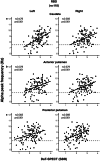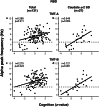EEG alpha peak frequency: cognitive impairment severity marker in isolated REM sleep behavior disorder
- PMID: 40593883
- PMCID: PMC12218050
- DOI: 10.1038/s41531-025-01059-z
EEG alpha peak frequency: cognitive impairment severity marker in isolated REM sleep behavior disorder
Abstract
Isolated REM sleep behavior disorder (iRBD) is a prodrome of α-synucleinopathies like Parkinson's disease (PD) and dementia with Lewy bodies (DLB). The best marker for prediction of lead time to phenoconversion is reduced striatal dopamine transporter (DaT)-binding, unavailable for most patients. This study investigated EEG alpha peak frequency (APF) slowing - an established marker of cognitive deterioration - as a severity marker in iRBD patients. In 320 patients clinically suspected of RBD 3-night-polysomnography was performed. After exclusion of 131 patients, mainly due to psychotropic medication, three groups were studied: Non-Syn - motor behavior unrelated to RBD (n = 34); iRBD (n = 122); RBD converted to overt α-synucleinopathies (PD = 19; DLB = 14). Data show in patients with iRBD significant correlations between APF, DaT-binding ratios and cognition. The strong correlation of APF < 8 Hz with caudate DaT-binding (r = 0.50-0.65) suggests, APF could be an easy-to-use severity marker for counseling patients on lead time until possible conversion to overt α-synucleinopathy especially in DLB.
© 2025. The Author(s).
Conflict of interest statement
Competing interests: The authors declare no competing interests.
Figures





Similar articles
-
Electroencephalographic spectro-spatial covariance patterns related to phenoconversion in isolated rapid eye movement sleep behavior disorder and their longitudinal trajectories in α-synucleinopathies.Sleep. 2024 Jun 13;47(6):zsae052. doi: 10.1093/sleep/zsae052. Sleep. 2024. PMID: 38482885
-
EEG-based machine learning models for the prediction of phenoconversion time and subtype in isolated rapid eye movement sleep behavior disorder.Sleep. 2024 May 10;47(5):zsae031. doi: 10.1093/sleep/zsae031. Sleep. 2024. PMID: 38330231
-
Basal Forebrain Volume Predicts Disease Conversion in Prodromal Synucleinopathy.Mov Disord Clin Pract. 2025 Jul 22. doi: 10.1002/mdc3.70242. Online ahead of print. Mov Disord Clin Pract. 2025. PMID: 40693521
-
Cholinesterase inhibitors for dementia with Lewy bodies, Parkinson's disease dementia and cognitive impairment in Parkinson's disease.Cochrane Database Syst Rev. 2012 Mar 14;2012(3):CD006504. doi: 10.1002/14651858.CD006504.pub2. Cochrane Database Syst Rev. 2012. PMID: 22419314 Free PMC article.
-
Structural and functional magnetic resonance imaging in isolated REM sleep behavior disorder: A systematic review of studies using neuroimaging software.Sleep Med Rev. 2021 Oct;59:101495. doi: 10.1016/j.smrv.2021.101495. Epub 2021 Apr 22. Sleep Med Rev. 2021. PMID: 33979733
References
-
- Schenck, C. H., Bundlie, S. R., Patterson, A. L. & Mahowald, M. W. Rapid eye movement sleep behavior disorder. A treatable parasomnia affecting older adults. Jama257, 1786–1789 (1987). - PubMed
-
- Cicero, C. E. et al. Prevalence of idiopathic REM behavior disorder: a systematic review and meta-analysis. Sleep44, zsaa294 (2021). - PubMed
-
- Galbiati, A., Verga, L., Giora, E., Zucconi, M. & Ferini-Strambi, L. The risk of neurodegeneration in REM sleep behavior disorder: a systematic review and meta-analysis of longitudinal studies. Sleep. Med. Rev.43, 37–46 (2019). - PubMed
-
- Schenck, C. H., Boeve, B. F. & Mahowald, M. W. Delayed emergence of a parkinsonian disorder or dementia in 81% of older men initially diagnosed with idiopathic rapid eye movement sleep behavior disorder: a 16-year update on a previously reported series. Sleep. Med.14, 744–748 (2013). - PubMed
LinkOut - more resources
Full Text Sources
Miscellaneous

